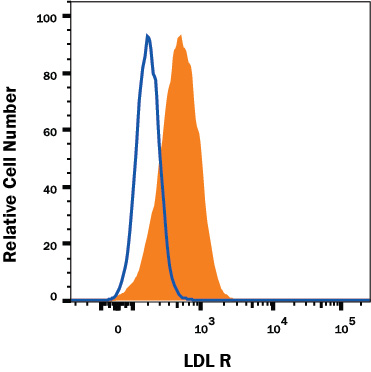Mouse LDLR PE-conjugated Antibody Summary
Ala22-Arg790 (Ala23Val, Cys27Gly)
Accession # Q6GTJ9
Applications
Please Note: Optimal dilutions should be determined by each laboratory for each application. General Protocols are available in the Technical Information section on our website.
Scientific Data
 View Larger
View Larger
Detection of LDL R in RAW 264.7 Mouse Cell Line by Flow Cytometry. RAW 264.7 mouse monocyte/macrophage cell line, deprived of serum for 24 hours, was stained with Rat Anti-Mouse LDL R PE-conjugated Monoclonal Antibody (Catalog # FAB2255P, filled histogram) or isotype control antibody (Catalog # IC006P, open histogram). View our protocol for Staining Membrane-associated Proteins.
Reconstitution Calculator
Preparation and Storage
- 12 months from date of receipt, 2 to 8 °C as supplied.
Background: LDLR
The low density lipoprotein receptor (LDL R) is the founding member of the LDL R family of scavenger receptors (1, 2, 3, 4). This family contains type I transmembrane molecules that are characterized by the presence of EGF repeats, complement-like repeats, and YWTD motifs that form beta -propellers. Although members of the family were originally thought to be endocytic receptors, it is now clear that some members interact with adjacent cell-surface molecules, expanding their range of activities (2, 4). Mouse LDL R is synthesized as a 864 amino acid (aa) precursor that contains a 21 aa signal sequence, a 769 aa extracellular region, a 22 aa transmembrane segment and a 52 aa cytoplasmic tail (5). The extracellular region is complex. It consists of seven N-terminal complement-like cysteine-rich repeats (class A LDL domains) that bind LDL. Cysteines in this region participate in intrachain disulfide bonds. This region is followed by two EGF-like domains and six class B LDL repeats that generate a beta -propeller whose blades each contain a YWTD motif. This area is likely responsible for ligand dissociation (6). Finally, there is a 50 aa membrane proximal Ser/Thr-rich region that shows extensive O-linked glycosylation, generating a native molecular weight for LDL R of 135 kDa (5). Within the 52 aa cytoplasmic region, there is an NPxY motif that links the receptor to clathrin pits and binds to select adaptor proteins (1, 7, 8). The extracellular region of mouse LDL R shares 78% and 87% aa identity with the extracellular region of human and rat LDL R, respectively. LDL R is constitutively expressed and binds apoB of LDL and apoE of VLDL (9). It is responsible for clearing 70% of plasma LDL in liver (9).
- Strickland, D.K. et al. (2002) Trends Endocrinol. Metab. 13:66.
- Nykjaer, A. and T.E. Willnow (2002) Trends Cell Biol. 12:273.
- Gent, J. and I. Braakman (2004) Cell. Mol. Life Sci. 61:2461.
- Bujo, H. and Y. Saito (2006) Arterioscler. Thromb. Vasc. Biol. 26:1246.
- Hoffer, M.J. V. et al. (1993) Biochem. Biophys. Res. Commun. 191:880.
- Rudenko, G. and J. Deisenhofer (2003) Curr. Opin. Struct. Biol. 13:683.
- Trommsdorff, M. et al. (1998) J. Biol. Chem. 273:33556.
- Stolt, P.C. and H.H. Bock (2006) Cell. Signal. 18:1560
- Defesche, J.C. (2004) Semin. Vasc. Med. 4:5.
Product Datasheets
FAQs
No product specific FAQs exist for this product, however you may
View all Antibody FAQsReviews for Mouse LDLR PE-conjugated Antibody
There are currently no reviews for this product. Be the first to review Mouse LDLR PE-conjugated Antibody and earn rewards!
Have you used Mouse LDLR PE-conjugated Antibody?
Submit a review and receive an Amazon gift card.
$25/€18/£15/$25CAN/¥75 Yuan/¥2500 Yen for a review with an image
$10/€7/£6/$10 CAD/¥70 Yuan/¥1110 Yen for a review without an image


